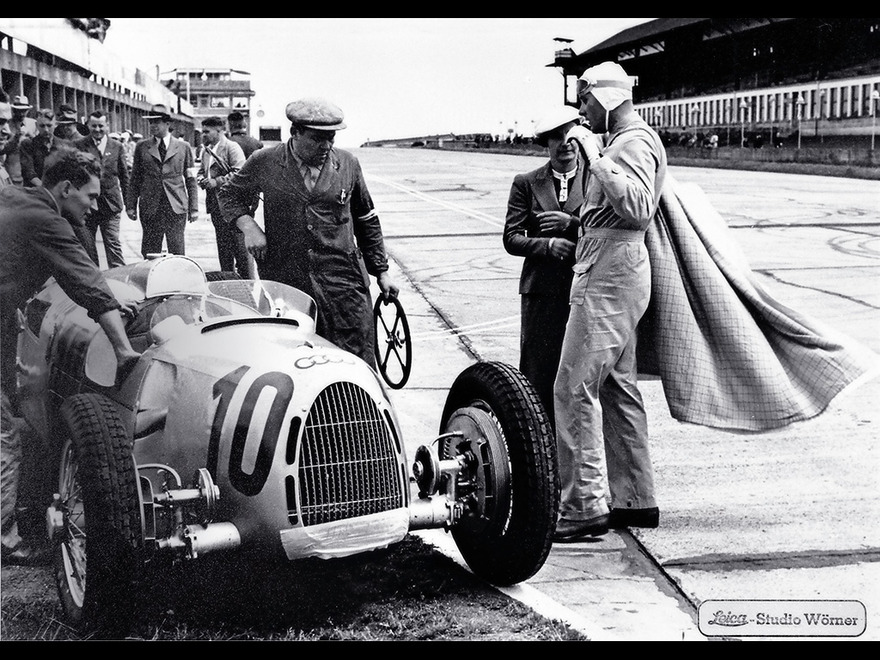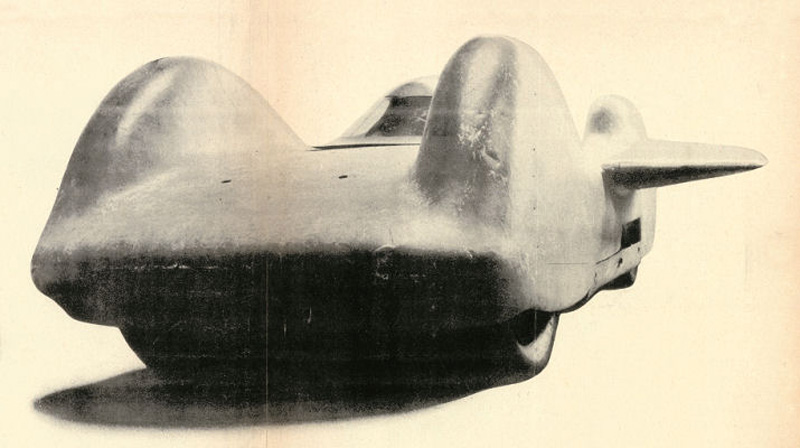«The desire of my life — to become the fastest man in the world. I'll get to do all the sacrifice, put all my strength „- so wrote in his letter to the leadership of Daimler-Benz known racer Hans Stuck. It was October 13, 1936. Six years of his life to the pilot to realize a dream. He could achieve incredible heights, but fate decided otherwise...
Hans Stuck intended to go down in history. After the speech, the head of the National Socialist Corps (NSKK) Adolf Hyunlayna («If who is currently in the hands of the British land speed record will be to win, and it will belong to Germany, then we must use every opportunity. This fight must be conducted in a chivalrous and In no case should not be played „) racer decided to set a record speed — dispersed over 600 km / h. It was the creation of the car.
In the middle of 1936 Hans Stuck met with Ernst Udet, who during the First World War was a successful pilot and hero. The mood at record speed racer needed aircraft engine — the «heart» of the latest fighter Luftwaffe Messerschmitt Bf 109. The head of the Ministry of the German Air Force Corps of Engineers listened to the proposal and gave oral consent to the use of engines Daimler DB-603. The most absurd project in the history of German automotive sports began with the words from a letter Hans Stuck to the head of the company Mercedes-Benz William Kissel on August 2, 1936: «For several years, I wear the idea of creating the fastest car on earth. I've already talked about it with Prof. Porsche some time ago, and he expressed his willingness to assist in the development of the car for me. »
The history of construction of the car T80 record reveals to us the mystery of Engineering from the correspondence between the thing and Kissel, which has been preserved in the archives of Mercedes-Benz. Before us is a true human drama. Literary columnist Michael Hengshtenberg writes: «The letters tell the history of the life of a driver who with the help of the incredible, bordering on insanity act like again bring back the glory, but his plans have stalled in a bureaucratic wheel German industrial drive of the day. Hastily, like who can not wait for the child, Stuck attacked the head of the company Mercedes-Benz Kissel letters and telegrams. Often several times a week. »
At the beginning of the way to the realization of the dream Hans Stuck wrote to the head of Daimler-Benz: «You see, I'm in a rush, but otherwise I feel fine.» He waited for participation, because the firm could be a huge success thanks to the plan of the rider. A month later, on 24 October 1936, Hans Stuck says: «I think it likely that the dream of my life is really in front of me and I want to reassure you that I am in any case, 100% fit.» Why is one of the best riders in Germany tried to convince the necessary people in their proficiency, because it is his idea to put the record speed in spite of everything?
The German driver was patient, but at the same time could not write letters. So, 16 years oktyabrya1937, William Kissel received a telegram: «Dear Mr. Director, I am not in any way do not want to pressure you, but the last 14 months, and I have to find out if ever finish our business.»
Stuck for a long time to be confirmed by Daimler-Benz. His tone became more insistent: «Having returned from South America on the path of the Spa at the Nurburgring, I once again appeal to you. You kindly promised me that after my return from Rio, you can give me a final written decision that the project, which aims to establish speed records, will be implemented with my participation. »
The work went slowly. The project bore private character, and Mercedes-Benz were not as tied financially, just like any other German company at that time. Hans Stuck offered to withdraw from the company of the cost. His best friend, Swiss Baron de Blonay and Max Klinger were ready to give more than 600 000 German marks for the project the fastest car on earth, but one close Kissel, Alfred Neubauer, dryly commented on this proposal: «I remind you of the expedition Mr. Stuck in South America, he also partially funded from its own resources. He finally asked for money, because otherwise he would not have to do the job. »
The reality is revealed in a letter to Hans Stuck mid-1937: «As a pilot factory of the company Auto Union was refused in an attempt to establish a record for a rival firm in which I work for Daimler-Benz. I therefore stand before the decision, according to which I should cease my employment contract with the company Auto Union, it allowed me to take part in the attempt to establish a speed record. Or do I have to choose a more reliable option and earn a living at my current employer, racing Grand-Prix, but with the risk of your dreams? »
Kissel promises that it would be Hans Stuck at the wheel of Mercedes T80 sounded convincing, but... Employees Daimler-Benz were against the candidacy pieces. Their favorite was Rudolf Caracciola, who successfully conquered the podium for the team Mercedes. The matter would have come to a standstill and, but came to power, Adolf Hitler craved big victories. It was he who supported the project, Hans Stuck. The Fuhrer was an ardent fan of Mercedes and insisted that Germany won the speed record. He T80 nicknamed «black bird» and certainly believed in the victory of the car, which, of course, ought accordingly to paint the car and decorate German eagle and swastika.
In late summer 1938 Mercedes T80 project gained new impetus. In the US, competition was held among the fastest cars. Pilots John Cobb and George Eyston arrived at Bonneville Flats in order to establish a new speed record. When George Estonia on its racing cars Thunderbolt was able to develop a speed of 575 km / h, and a year later at the wheel Railton has raised the bar to a phenomenal 595 km / h, Adolf Hitler gave the task to disperse the T80 up to 650 km / h, although the developers realized that reach a maximum up to 600 km / h.
For engineers, the question arose relatively strong «obuvki» future champion. The company Dunlop had extensive experience in the manufacture of tires designed for the highest speeds, but the British company was not taken into account. Although this problem has remained unsolved for a long time, responsible for the development of the project engineer Ferdinand Porsche reported the experimental successes. T80 engine for the very first bench tests developed power 2000 hp By means of special additives to the fuel, without problems could be to increase the power to 3000 hp
Aviastroitel Henkel designed and tested in the laboratory aerodynamic car body, which were located on the sides of the elements of the design similar to the wing root, which managed to squeeze great vehicle to the road surface. Fully «licked» body made T80 «King of aerodynamics.» In order to avoid slipping four driving wheels, Ferdinand Porsche for the first time developed a special system of automatic traction. Porsche paid particular attention to weight loss and longitudinal stability of the vehicle (in some places the thickness of the outer skin of dyurallyuminievyh alloys decreased to 0.3 mm). As a comparison, the British car-record holder was 2 times heavier than the Mercedes T80. Thanks to successful arrangement of the engine and sliding clutch (car did not have the usual gearbox and engine torque is transmitted directly to the wheels through the clutch assembly) Ferdinand Porsche has achieved nearly optimal weight distribution. The driver sat at the front of the car body in a glass cockpit fairing. Mercedes T80 had four-wheel drive, and a giant drum brakes provide the necessary braking force to stop a heavy vehicle.
In early 1939 T80 was almost ready. Specifications «black bird» turned diabolical, to say the least. Her «heart» — V-shaped 12-cylinder engine of 44,5litra equipped with compressors and direct fuel injection, developed 3,000 hp, working on a mixture of methanol (63%), benzene (16%) ethanol (12%), acetone (4.4%), nitrobenzene (2.2%), aviation gasoline (2%) and ether (0.4%). Liquid methanol cooled the entire system pressurization. According to calculations of the car had to accelerate to 750 km / h, and it is a hundred more than was originally intended. The record speed was in the hands of the Germans!
It remained to find a suitable racing track for the test in advance. Dried salt lakes of the USA did not fit. The Germans were suggestions that the US government could legally confiscate T80 in case of an accident. The newest aircraft engine would get to opponents. Adolf Hitler ordered to check the maximum speed occurred in the vast Germany. We chose a line under the highway Dessau. On a straight section of a length of 10 km it was deleted by separating bump. Traces of dismantling manually covered with concrete, but the surface is undulating and turned unsuitable as a race track. Despite this, the test drive to establish a new world record was appointed Hans Stuck on January 1940. However, the first day of September 1939 marked the end of the project for the T80. Hope Stuck, Kissel and Porsche have turned into nothing. World War II began.
Only once, in February 1940, flashed mention of never broken record. William Kissel wrote: «Now the project is stopped. The car and the individual elements of its design carefully packaged and prepared for storage so that after the war to continue. We hope that will be able to bring our plans to the end. » But in 1947, the Briton John Cobb has set a new speed record of 647 km / h. Time has overtaken like a UFO vehicle with short wings and mad «heart.» And numerous mysteries added one more — a letter by Daimler employees asking for compensation for the cost of project development in the T80 600 000 DM has not been found, and Mercedes T80 could not pass a single time on the track.
Today the body of T80 is in the museum of concern Mercedes-Benz in Stuttgart. The chassis of this car was using bolts firmly attached to the pedestal under a canopy of external storage of the museum. Interweaving the saddest fate of the rider and the vehicle remained on the old tattered paper.
Information: Michel Hengshtenberga article archive and Mercedes-Benz













